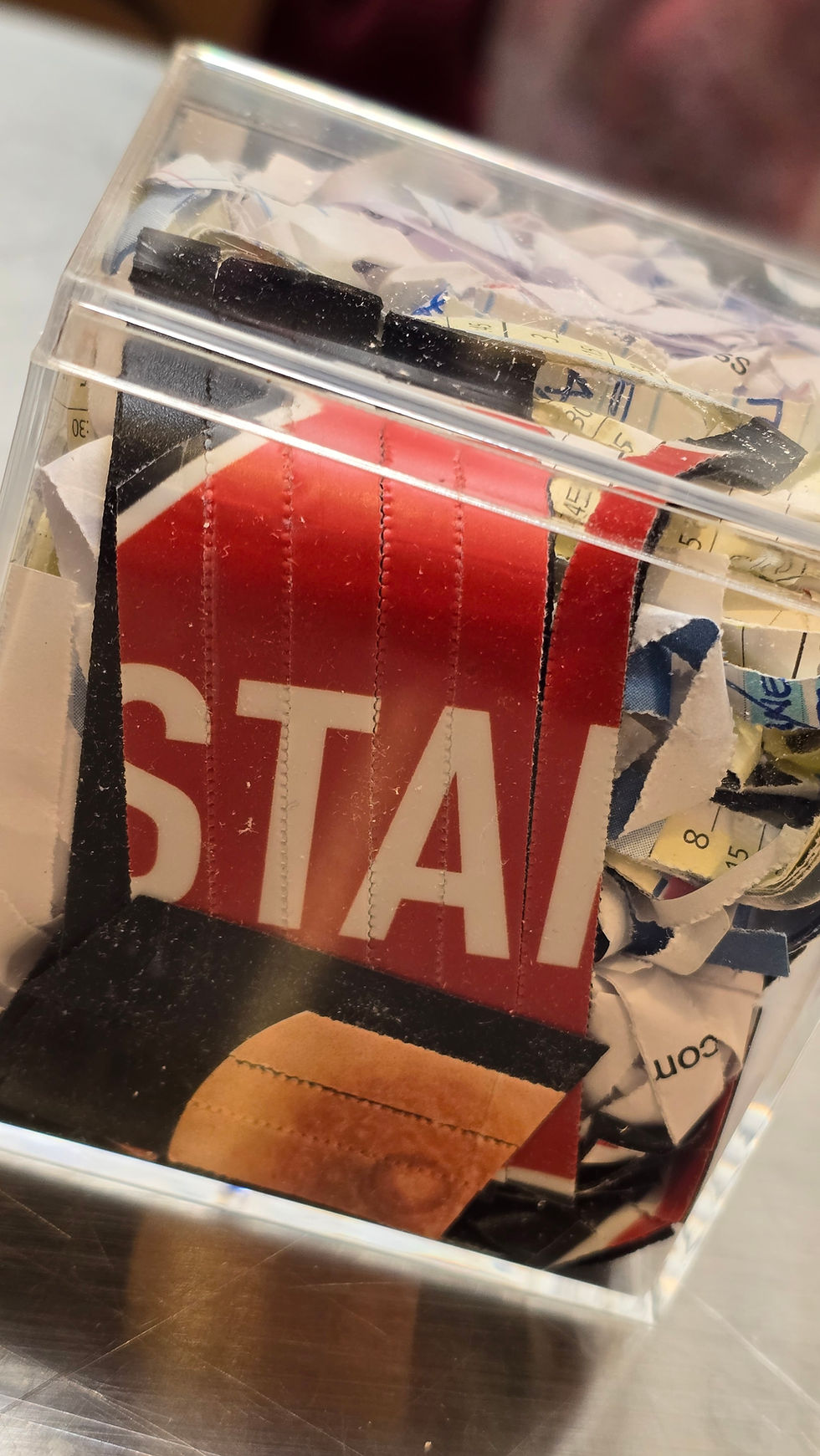The Wall That Holds Us All
- Kristine Schomaker
- Aug 1
- 3 min read
I've been sitting with this tension for months now, surrounded by thousands of fragments of my shredded history, trying to figure out what comes next. Yesterday I read an article about art collectors bidding hundreds of thousands at auctions, buying work because their friends bought that artist, and something clicked.
My imaginary wall isn't just personal anymore.
What the Wall Really Is
For over ten years I've been cutting up my art—paintings, photographs, even my own hair preserved in jars. This cutting has been my meditation, my way of processing trauma and making space for transformation. But as I sit here surrounded by gift bags full of shredded pieces, pricing acrylic cubes filled with 52 years of my history at $50 each (with $10 going to eating disorder charity), I'm realizing something bigger is happening.
The wall isn't just made of eating disorder struggles and body image fears. It's constructed from the contradictions of being an artist who needs to survive financially while creating work that fundamentally critiques the systems demanding commodification.
I'm literally asking: how much is my trauma worth?
Accidentally Doing Institutional Critique
When I said in a voice memo the other day, "maybe this is an institutional critique of capitalism, and I'm just now diving into it," I was recognizing what's already happening in my practice. My decade of cutting up art, my refusal to be trapped by past selves, my resistance to accumulation—this is already challenging systems that demand we hold onto, display, and monetize our creative output.
The imaginary wall represents all the ways capitalism teaches us to self-limit.
My reaction to that collector article revealed something crucial: my desire for my art to be owned by people who "feel it, understand it, get it"—many of whom can't afford art—exposes the fundamental contradiction of needing money to make art while wanting art to serve healing rather than status.

The Van Fantasy
There's this part of me that wants to sell everything, buy a van, and travel. Work from my van. Go minimal. Stop relying on money because money has been a stressor my whole life and I want that to change.
This isn't just escapist dreaming. It's the logical conclusion of breaking through the imaginary wall. It represents freedom from accumulation, from studio rent, from the infrastructure that both enables and constrains my practice. Working from a van would be the ultimate reconstruction phase—creating from intentional minimalism.
But I'm on a credit card buying these cubes. I need money. The wall stops me.
Breaking Through vs. Living With
A friend recently suggested I just dump everything—all the shredded pieces, the jars of hair, everything. Make it a private act between me and the dumpster rather than some performance piece. Feel the freedom, the space created, the weight lifting.
This represents the ultimate breakthrough—complete letting go. But my honest response shows the complexity: I need money, and letting go completely might mean sacrificing financial survival.
Every day it's like a roller coaster in how I feel about these questions. The imaginary wall isn't a problem to be solved but a tension to be lived with. Some days the wall feels like protection (keeping me from pure financial vulnerability), other days it feels like limitation (preventing the freedom of letting go completely).

Art as Survival Tool vs. Art as Product
I use art as conceptual journal, conceptual diary, conceptual note-taking. Tools for figuring out and getting through life. This functional approach conflicts with market demands for discrete, sellable objects.
My imaginary wall work makes this tension visible by turning the process of working through trauma into something people can experience. When community members help me apply the dots during installation, they're not just helping with setup—they're participating in the deconstruction of barriers that keep us all from becoming who we're meant to be.
The Real Breakthrough
Rather than seeing this tension as something to resolve, maybe learning to live creatively within these contradictions is the actual breakthrough. The wall becomes transparent when I stop trying to eliminate the tension between art-as-healing and art-as-survival, and instead make that tension part of the work itself.
My imaginary wall project succeeds precisely because it makes visible the impossible choices most artists face privately. By sharing the process publicly—the financial stress, the collector problem, the van fantasy, the daily roller coaster—I'm creating community around these struggles rather than treating them as personal failures.
The wall exists. It's real in its effects but constructed in its nature. Which means it can be deconstructed, dot by dot, breath by breath, contradiction by contradiction, until we find ways to live authentically within systems that weren't designed for our liberation.
Sometimes breakthrough isn't about eliminating barriers. Sometimes it's about making them transparent enough that we can see through to what's possible on the other side.







This was a breakthrough article for me. The concept can actually be applied to almost every aspect of our lives. By you exposing this mindset, in of itself, is a breakthrough. I think you just helped me shift some things and for that I’m am grateful. Thank you Kristine!